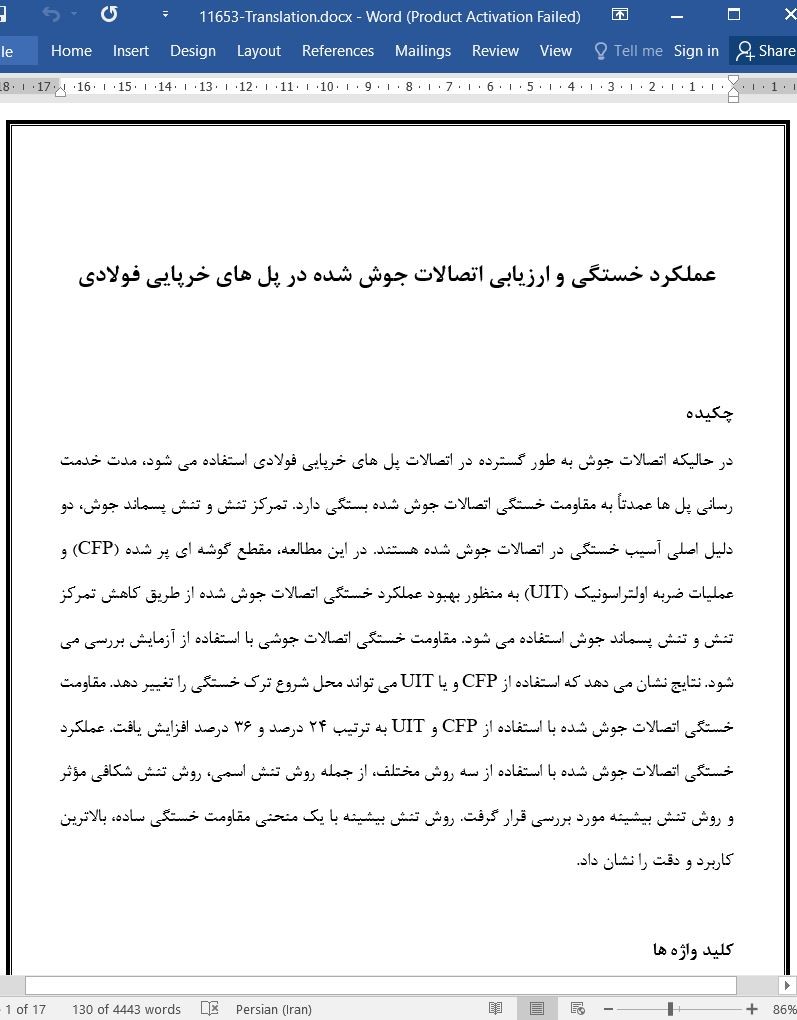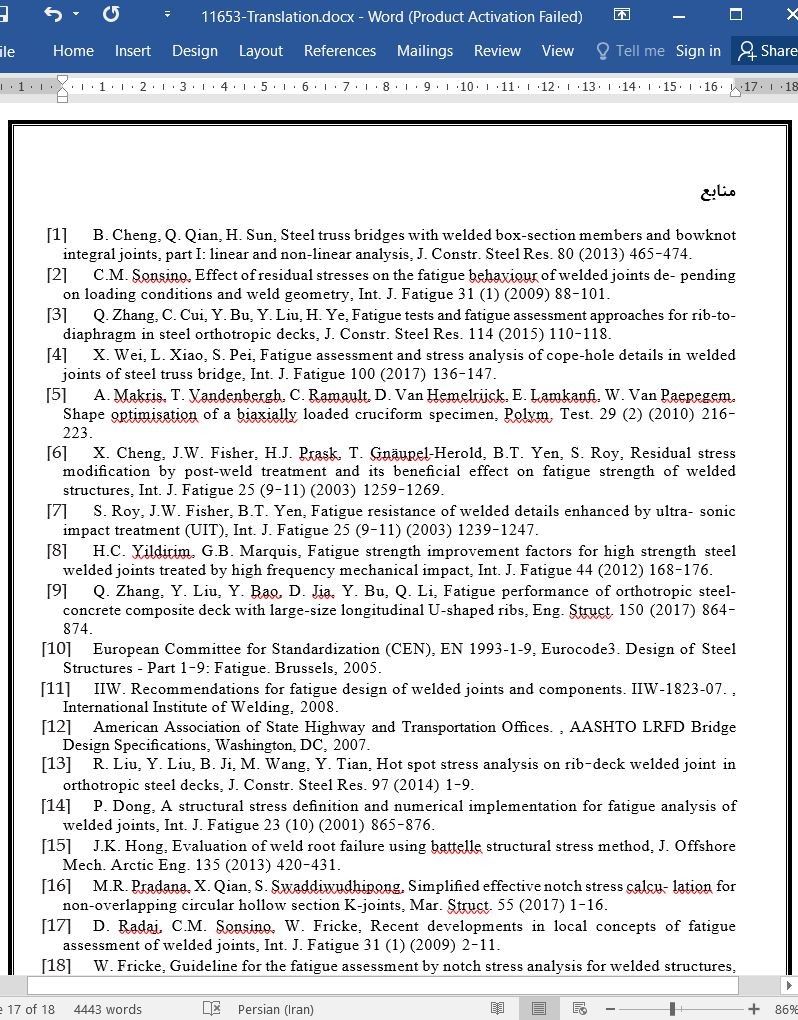
عملکرد خستگی و ارزیابی اتصالات جوش شده در پل های خرپایی فولادی
چکیده
در حالیکه اتصالات جوش به طور گسترده در اتصالات پل های خرپایی فولادی استفاده می شود، مدت خدمت رسانی پل ها عمدتاً به مقاومت خستگی اتصالات جوش شده بستگی دارد. تمرکز تنش و تنش پسماند جوش، دو دلیل اصلی آسیب خستگی در اتصالات جوش شده هستند. در این مطالعه، مقطع گوشه ای پر شده (CFP) و عملیات ضربه اولتراسونیک (UIT) به منظور بهبود عملکرد خستگی اتصالات جوش شده از طریق کاهش تمرکز تنش و تنش پسماند جوش استفاده می شود. مقاومت خستگی اتصالات جوشی با استفاده از آزمایش بررسی می شود. نتایج نشان می دهد که استفاده از CFP و یا UIT می تواند محل شروع ترک خستگی را تغییر دهد. مقاومت خستگی اتصالات جوش شده با استفاده از CFP و UIT به ترتیب 24 درصد و 36 درصد افزایش یافت. عملکرد خستگی اتصالات جوش شده با استفاده از سه روش مختلف، از جمله روش تنش اسمی، روش تنش شکافی مؤثر و روش تنش بیشینه مورد بررسی قرار گرفت. روش تنش بیشینه با یک منحنی مقاومت خستگی ساده، بالاترین کاربرد و دقت را نشان داد.
مقدمه
خرپاهای فولادی به طور گسترده ای در پل های راه آهن و پل های بزرگراه هیبریدی(ترکیبی) استفاده شده است. پل های خرپایی فولادی معمولاً با مونتاژ اعضای خرپایی پیش ساخته در سایت(محل) ساخته می شوند. شکل 1 (a) و (b) نشان دهنده یک سطح مقطع نمایشی از یک شاهتیر اصلی در یک پل بزرگراه- راه آهن ترکیبی است. شاهتیر با استفاده از قطعات مختلف خرپا، از جمله وتر ها، دیرک های عمودی، عناصر قطری و غیره ساخته و مونتاژ می شود. قطعات با استفاده از جوشکاری و یا با استفاده از پیچ های با مقاومت بالا به هم متصل می شوند. اتصالات جوشی ترکیبی (شکل 1 (b)) معمولاً در کارخانه پیش ساخته شده اند تا کیفیت جوشکاری بالای داشته باشند. اتصالات جوشی بین ورق بال و ورق های لچکی تحت تنش های کششی متغیر و دیگر اثرات نامطلوب بر مقاومت خستگی قرار می گیرند و در نتیجه مستعد آسیب های خستگی هستند. به طور کلی، اثرات نامطلوب شامل تمرکز تنش، عیوب جوش و تنش های پسماند در اتصالات جوشی است [4-1]. تحت بارگذاری سیکلی، ترک ها تمایل دارند تا در اتصالات جوشی شروع شوند (شکل 1 (b)) و پایداری بلند مدت پل خرپایی را به خطر بیاندازند.
5. نتیجه گیری
نتیجه گیری های اصلی به صورت زیر خلاصه می شود:
(1) استفاده از CFP و / یا UIT مود گسیختگی خستگی اتصالات جوش شده را تغییر می دهد. ترک های خستگی در لبه های ورق بال برای اتصالات جوش شده بدون CFP و در سطح ورق بال برای اتصالات جوش شده با CFP شروع می شود. ترک خستگی در ریشه یا پنجه جوش اتصالات جوش شده با UIT و در پنجه جوش اتصالات جوش شده بدون UIT شروع می شود.
(2) استفاده از CFP و UIT، مقاومت خستگی اتصالات جوش شده را به ترتیب 24 درصد و 36 درصد افزایش داد. استفاده ترکیبی از CFP و UIT مقاومت خستگی را 60 درصد افزایش داد. در مقایسه با CFP، استفاده از UIT در بهبود مقاومت خستگی مؤثرتر بود.
Abstract
While welded joints are extensively used in the connections of steel truss bridges, service life of the bridges is largely dependent on the fatigue resistance of the welded joints. Stress concentration and weld residual stress are two primary causes of fatigue damage in the welded joints. In this study, corner-fillet profile (CFP) and ultrasonic impact treatment (UIT) are used to improve the fatigue performance of the welded joints through relieving stress concentration and weld residual stresses, respectively. The fatigue resistance of welded joints is evaluated through experimentation. The results indicate that the use of CFP and/or UIT can alter the initiation location of fatigue crack. The fatigue resistance of welded joints was increased by 24% and 36% by using the CFP and UIT, respectively. The fatigue performance of welded joints was evaluated using three different methods, including the nominal stress method, effective notch stress method, and peak stress method. The peak stress method with a single fatigue resistance curve demonstrated the highest applicability and accuracy.
1. Introduction
Steel trusses have been extensively used in railway bridges and hybrid highway-railway bridges. Steel truss bridges are typically constructed by assembling prefabricated truss components on site. Fig. 1 (a) and (b) show a representative cross section of a main girder in a hybrid highway-railway bridge. The girder is assembled using different truss components, including the chords, vertical posts, diagonal elements, etc. The components are connected through welding and/or using high-strength bolts. Integrated welded joints (Fig. 1(b)) are usually prefabricated in factory to ensure high welding quality. The welded joints between the flange and gusset plates are subjected to varying tensile stresses and other adverse effects on fatigue resistance, and thus susceptible to fatigue damages. In general, the adverse effects include stress concentration, weld defects and residual stresses at welded joints [1–4]. Under cyclic loading, cracks tend to initiate at the welded joints (Fig. 1(b)) and compromise the long-term durability of the truss bridge.
5. Conclusions
The main conclusions are summarized as follows:
(1) The use of CFP and/or UIT changed the fatigue failure mode of the welded joints. Fatigue cracks initiate at the flange plate edges for the welded joints without CFP, and on the flange plate surface for the welded joints with CFP. Fatigue cracks initiate at the weld root or weld of the welded joints with UIT, and at the weld toe of the welded joints without UIT.
(2) The use of CFP and UIT increased the fatigue resistance of welded joints by 24% and 36%, respectively. Combined use of CFP and UIT increased the fatigue resistance by 60%. Compared with CFP, the use of UIT was more effective in enhancing the fatigue resistance.
چکیده
1. مقدمه
2. برنامه آزمایشگاهی
2.1. نمونه ها
2.2. برپایی(set up) آزمایش و پروتکل(روند) بارگذاری
3. بحث و نتیجه گیری آزمایشگاهی
3.1. نتایج آزمایش
3.2. تحلیل گسیختگی
4. ارزیابی مقاومت خستگی
4.1. روش تنش اسمی
4.2. روش تنش ناچ(شکافی) مؤثر
4.3. روش تنش بیشینه
5. نتیجه گیری
منابع
Abstract
1. Introduction
2. Experimental program
2.1. Specimens
2.2. Test setup and loading protocol
3. Experimental results and discussion
3.1. Testing results
3.2. Failure analysis
4. Fatigue resistance evaluation
4.1. Nominal stress method
4.2. Effective notch stress method
4.3. Peak stress method
5. Conclusions
1. References
- ترجمه فارسی مقاله با فرمت ورد (word) با قابلیت ویرایش، بدون آرم سایت ای ترجمه
- ترجمه فارسی مقاله با فرمت pdf، بدون آرم سایت ای ترجمه



